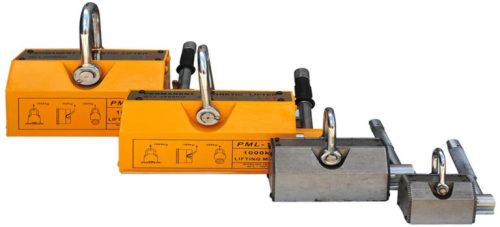Permanent Magnetic Lifter
- General information
- Learn More
- Property Table

- PML-1, PML-2, PML-3, PML-5, PML-6, PML-10, PML-15, PML-20, PML-30, PML-50, PML-60
Model PML permanent magnetic lifter is mainly used to fasten or hold iron workpieces during lifting or handling operation. It is able to hold the iron plate and cylindrical steel durably and firmly during moving, which is widely used as hoist devices in factories.
Model PML permanent magnetic lifter has strong magnetic circuit produced by NdFeB magnetic materials. It is easy and safe for operation, convenient for carrying and efficient for use.
Max pull-off strength for lifter (safety factor), typical safety factor is 3:1, 3.5:1 (Max pull-off strength : Rated Capacity (plate)).
We are able to custom the shape and coating for your specific requirements.
General Introduction
Model PML permanent magnetic lifter is mainly used to fasten or hold iron workpieces during lifting or handling operation. It is able to hold the iron plate and cylindrical steel durably and firmly during moving, which is widely used as hoist devices in factories.
Features
Model PML permanent magnetic lifter has strong magnetic circuit produced by NdFeB magnetic materials. It is easy and safe for operation, convenient for carrying and efficient for use.
Typical Models
PML-1, PML-2, PML-3, PML-5, PML-6, PML-10, PML-15, PML-20, PML-30, PML-50, PML-60;
Model Specification
- Rated Capacity (Plate), safety range of holding strength on plate metals;
- Cylindrical Capacity, safety range of holding strength on cylindrical metals;
- Max Pull-off Strength, Max pull-off strength for lifter (safety factor), typical safety factor is 3:1, 3.5:1 (Max pull-off strength : Rated Capacity (plate));
- Max working temperature is restricted by the features of Neodymium magnets.
Influence Factor
Affected by thickness and surface of the workpiece.
Before operation, it is necessary to find out its effective capacity on that thickness according to STEEL THICKNESS percentage curve. Also, care and estimate the effective capacity on that surface condition according to the AIRGAP percentage curve.



For surface quality, if the roughness (Ra) is less than 6.3um, the effective lifting capacity can be as 100%. If the surface roughness (Ra) is above 6.3um or even worse, the airgap between lifter and workpiece should be estimated. Find out the effective capacity on this airgap from the curve percentage. Combining both factors then calculates the actual lifting capacity on this condition.
Affected by the composition of the workpiece
Taking lifter’s capacity for low-carbon steel plate as standard in coefficient 1, after measurement, the capacity coefficient for medium-carbon steel is 0.95, for high-carbon steel is 0.90, for low-alloy steel is 0.75 and for cast iron is 0.50.
Safety Tips
- Before operation, please read the operating instruction carefully to avoid accident.
- Avoid of being bumped, which affected its life-span and never bump handle or damage holding surface.
- Inspect the handle frequently to make sure its slide key can move flexibly and the stop pin can lock firmly.
- It is forbidden to turn the lifter’s handle without the iron workpiece contacting to its holding surface.
- Maintenance must be executed by authorized or professional technicians and must strictly follow the instructions.
- It is forbidden to modify the magnetic lifter to avoid safety risk.
- If its main body and turning parts is damaged that cannot work again, then it should be discarded as useless.
General Introduction
Model PML permanent magnetic lifter is mainly used to fasten or hold iron workpieces during lifting or handling operation. It is able to hold the iron plate and cylindrical steel durably and firmly during moving, which is widely used as hoist devices in factories.
Features
Model PML permanent magnetic lifter has strong magnetic circuit produced by NdFeB magnetic materials. It is easy and safe for operation, convenient for carrying and efficient for use.
Typical Models
PML-1, PML-2, PML-3, PML-5, PML-6, PML-10, PML-15, PML-20, PML-30, PML-50, PML-60;
Model Specification
- Rated Capacity (Plate), safety range of holding strength on plate metals;
- Cylindrical Capacity, safety range of holding strength on cylindrical metals;
- Max Pull-off Strength, Max pull-off strength for lifter (safety factor), typical safety factor is 3:1, 3.5:1 (Max pull-off strength : Rated Capacity (plate));
- Max working temperature is restricted by the features of Neodymium magnets.
Influence Factor
Affected by thickness and surface of the workpiece.
Before operation, it is necessary to find out its effective capacity on that thickness according to STEEL THICKNESS percentage curve. Also, care and estimate the effective capacity on that surface condition according to the AIRGAP percentage curve.



For surface quality, if the roughness (Ra) is less than 6.3um, the effective lifting capacity can be as 100%. If the surface roughness (Ra) is above 6.3um or even worse, the airgap between lifter and workpiece should be estimated. Find out the effective capacity on this airgap from the curve percentage. Combining both factors then calculates the actual lifting capacity on this condition.
Affected by the composition of the workpiece
Taking lifter’s capacity for low-carbon steel plate as standard in coefficient 1, after measurement, the capacity coefficient for medium-carbon steel is 0.95, for high-carbon steel is 0.90, for low-alloy steel is 0.75 and for cast iron is 0.50.
Safety Tips
- Before operation, please read the operating instruction carefully to avoid accident.
- Avoid of being bumped, which affected its life-span and never bump handle or damage holding surface.
- Inspect the handle frequently to make sure its slide key can move flexibly and the stop pin can lock firmly.
- It is forbidden to turn the lifter’s handle without the iron workpiece contacting to its holding surface.
- Maintenance must be executed by authorized or professional technicians and must strictly follow the instructions.
- It is forbidden to modify the magnetic lifter to avoid safety risk.
- If its main body and turning parts is damaged that cannot work again, then it should be discarded as useless.